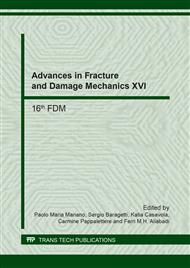p.198
p.202
p.206
p.210
p.214
p.218
p.222
p.226
p.230
Shear Mode Stress Intensity Factors for Serrated Crack Fronts
Abstract:
The paper is related to experiments on near-threshold fatigue cracks under shear modes II, III and II+III in bcc metals. Cylindrical bars with circumferential cracked notch were loaded by shear force. In-plane precracks with microtortuous geometry were created by compressive cyclic loading in mode I to measure the effective values of the remote crack driving force. Fatigue cracks in bcc metals loaded under remote shear modes II, III and II+III always grew by creation of local tongues loaded in mode II and their coalescence. Therefore, serrated precrack fronts of a linear roughness identical to those of the real fronts were modeled and the related local stress intensity factors k2 were calculated. Since such FEM calculation for various values of roughness were time consuming, a further task was to identify a lowest number of isolated teeth that produces k2 components identical with those created by the continuously serrated crack front. The results reported in this article reveal that this condition is fulfilled by only two isolated teeth.
Info:
Periodical:
Pages:
214-217
Citation:
Online since:
September 2017
Authors:
Price:
Сopyright:
© 2017 Trans Tech Publications Ltd. All Rights Reserved
Share:
Citation:


